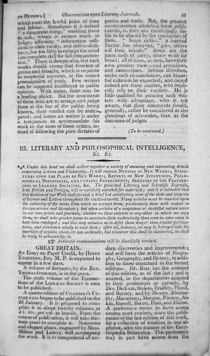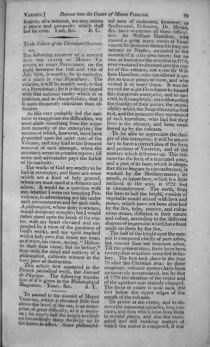|
The Christian Observer, 1802–77 | |
Sequence |
Volume 1, 1802 |
Editor |
Josiah Pratt, January–February? 1802 |
Publisher |
John Hatchard, 1802–63+ |
Printer |
Charles Whittingham, 1802+ |
Price |
1s. (1802) |
Format |
Demy 8vo. in 4s |
Pages |
62–80 (1802) |
Frequency |
Monthly |
Circulation |
Unknown |
Indexes |
All volumes: Index to the Essays, Intelligence, Occurrences, &c., Index to the Reviews, Index to the Principal Names, Index to the Texts |
Copies |
Leeds University Library |
Introduction | |

Although by no means the first, the Christian Observer was a relatively early specimen of the monthly religious magazine which in its many denominational and party forms came to play such a significant role in early nineteenth century culture. Its foundation can be traced to the Eclectic Society, a London-based discussion group of evangelical Anglicans, at a meeting of which, on 4 February 1799, the curate Josiah Pratt (1768–1844) raised the question, 'How far might a Periodical Publication be rendered subservient to the interest of Religion?' (Pratt 1856, p. 92). The ensuing discussion ultimately resulted in the publication, under Pratt's editorship, of the first issue of the Christian Observer in January 1802. There were, however, others significantly involved in shaping the project. Among those who helped to draw up the prospectus were Pratt's uncle, the Leeds surgeon William Hey (1736–1819) and Zachary Macaulay (1768–1838), who was a key member of the influential 'Clapham Sect' group of Anglican evangelicals. A committee was also established at the outset to superintend the magazine and consider contributions. This included Henry Thornton (who underwrote the magazine financially), William Wilberforce, John Venn, and Charles Grant—all of whom were key figures in the Clapham Sect—as well as fellow evangelical Hugh Pearson. Since Pratt was in fact too busy to edit the magazine, Macaulay took over the editorship 'before three months had elapsed' (Pratt 1856, p. 93), and many members of the Clapham Sect became regular contributors. The magazine thus developed into the house organ of the Claphamites, providing them with a means of fostering and defending their moderate and reasoned form of evangelicalism and of promoting their activist approach to public affairs and particularly to humanitarian causes. Pratt's original idea had been that a religious magazine would provide a means of correcting 'the false sentiments of the religious world' and 'explain the principles of the church', but he had also thought that it should contain miscellaneous and literary articles, reviews, as well as a historical register (Pratt 1856, p. 92). The prospectus for the Christian Observer set out these desiderata. It promised that the magazine would so 'combine information upon general subjects, with religious instruction, as to furnish such an interesting view of Religion, Literature, and Politics, free from the contamination of false principles, as a Clergyman may without scruple recommend to his Parishioners, and a Christian safely introduce into his Family' (vol. 1, p. iii). Thus, while the magazine would begin with 'Religious Communications', the second section was to comprise 'Miscellanies, comprehending interesting Particulars respecting the State of Man throughout the World [...] together with all such original Papers or Extracts, of an useful and instructive description, as cannot with propriety be classed under the first general head'. Succeeding sections were to consist of book reviews (chiefly of religious books), 'Intelligence, Literary, Philosophical, &c. &c. containing Notices of intended Publications, and of useful Discoveries in Science and Philosophy', a list of selected new publications, 'Religious Intelligence', a 'View of Public Affairs', and an obituary. In the event, the sections underwent some modification, but the magazine fulfilled its promise of producing a broadly based and cultured melange, in keeping with the Clapham Sect's self-image. Priced at one shilling, the Christian Observer was relatively inexpensive. However, the more populist religious magazines, such as the interdenominational Evangelical Magazine (1793–1904) and the Methodist Magazine (1778–1969), were priced at sixpence, and sold in the tens of thousands. While the Christian Observer rapidly rose to prominence, and apparently drew some Anglican evangelicals away from the Evangelical Magazine, its circulation was undoubtedly more modest than this, though circulation figures are not known (Altholz 1989, p. 46) . It was clearly intended as a magazine for Anglican evangelical gentlemen and their families, and less wealthy Anglican readers in search of an evangelical periodical could turn instead to the new sixpenny Christian Guardian (1802–53). | |
Notes on Indexing | |

The small sample of the Christian Observer indexed here exhibits the magazine in the first flush of editorial exuberance, but also displays the magazine in some degree of flux as the early editors experimented with the form. The magazine began with a tripartite structure, each of the main sections ('Miscellaneous', 'Literary', 'Historical') consisting of numbered subsections. First came the 'Miscellaneous Department', with subsections headed 'Biographical', 'Biblical', 'Theological', 'Ecclesiastical', and 'Various'. The last of these was to include 'interesting Particulars concerning the Works of God in CREATION and PROVIDENCE' and 'the History and State of MAN throughout the World' (vol. 1, p. 15), in earnest of which, the very first number contained an account of a descent into the crater of Mount Vesuvius by eight Frenchmen, extracted from the Philosophical Magazine with a commentary. Next came the 'Literary Department', consisting of 'Review of New Publications', 'Review of Reviews', 'Literary and Philosophical Intelligence', and a 'List of New Publications'. The third of these is obviously of particular interest here, and an editorial note in the first number reported that it was to contain 'amusing and interesting details concerning Letters and Philosophy', including 'REPORTS OF NEW INVENTIONS, PHILOSOPHICAL DISCOVERIES, AND CURIOUS EXPERIMENTS; SKETCHES OF THE PROCEEDINGS OF LEARNED SOCIETIES, &C.' (p. 35). By diligent scrutiny of the principal literary and scientific journals, the editor promised to give readers 'a brief but satisfactory view of the state and progress of Science and Letters throughout the civilized world', and the accounts were certainly strikingly detailed and extensive. Finally, the 'Historical Deparment' consisted of the 'State and Progress of Religion', 'A View of Public Affairs', chronicles of foreign and domestic occurrences, and finally an obituary. This initial format quickly underwent modification. After the first number, the 'Miscellaneous Department' ceased to be subdivided, but from the fourth number the contributed articles began to appear under two separate headings, 'Religious Communications' and 'Miscellaneous'. This was, the editor made clear, a response to readers' complaints: as one reader had pointed out, while the 'Essay on the Dry Rot' in the third number, was 'excellent in itself', its situation made it appear 'like a receipt for a Custard in a Volume of Sermons' (vol. 1, p. 280). The subsections of the literary department persisted, but those of the historical department underwent some streamlining, and by the sixth number the hierarchical structure and numbering of the various sections had been entirely flattened out. While the largest bulk of the scientific references appeared among the miscellaneous articles, and in the philosophical intelligence, references also appeared among the religious communications, the review of public affairs, and even the 'State and Progress of Religion'. | |
Bibliography | |
Altholz, Josef L. 1989. The Religious Press in Britain, 1760–1900, New York and London: Greenwood Press. Billington, Louis 1986. 'The Religious Periodical and Newspaper Press, 1770–1870', in The Press in English Society from the Seventeenth to Nineteenth Centuries, ed. by Michael Harris and Alan Lee, London: Associated University Presses, 113–32, 231–39. Hylson-Smith, Kenneth 1988. Evangelicals in the Church of England, 1734–1984, Edinburgh: T. & T. Clark. Overton, John H. 1894. The English Church in the Nineteenth Century (1800–33), London: Longmans, Green & Co. Pickering, Samuel F. 1974. 'Literature and Theology: The Christian Observer and the Novel, 1802–1822', Historical Magazine of the Protestant Episcopal Church, 43, 29–43. Pratt, John H., ed. 1856. Eclectic Notes; or, Notes of Discussions on Religious Topics at the Meetings of the Eclectic Society, London, During the Years 1798–1814, London: James Nisbet & Co. | |
Jonathan R. Topham (Nos. 1–6) and Fern Elsdon-Baker (Nos.7–12) | |